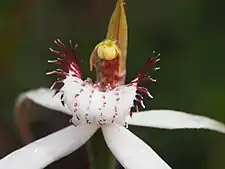| Darling Scarp white spider orchid | |
|---|---|
 | |
| Caladenia longicauda subsp. clivicola growing near Dunsborough | |
| Scientific classification | |
| Kingdom: | Plantae |
| Clade: | Tracheophytes |
| Clade: | Angiosperms |
| Clade: | Monocots |
| Order: | Asparagales |
| Family: | Orchidaceae |
| Subfamily: | Orchidoideae |
| Tribe: | Diurideae |
| Genus: | Caladenia |
| Species: | |
| Subspecies: | C. l. subsp. clivicola |
| Trinomial name | |
| Caladenia longicauda subsp. clivicola | |
| Synonyms[1] | |
|
Arachnorchis longicauda subsp.clivicola (Hopper & A.P.Br.) D.L.Jones & M.A.Clem. | |
Caladenia longicauda subsp. clivicola, commonly known as the Darling Scarp white spider orchid,[2] or hills white spider orchid[3] is a plant in the orchid family Orchidaceae and is endemic to the south-west of Western Australia. It has a single hairy leaf and up to three mostly white flowers with long, drooping lateral sepals and petals, a relatively small, narrow labellum and narrow labellum teeth. It grows in a restricted area, mostly on the Darling Scarp.

Description
Caladenia longicauda subsp. clivicola is a terrestrial, perennial, deciduous, herb with an underground tuber and a single hairy leaf, 120–250 mm (5–10 in) long and 6–12 mm (0.2–0.5 in) wide. Up to three, mostly white flowers 100–150 mm (4–6 in) long and 70–100 mm (3–4 in) wide are borne on a spike 300–500 mm (10–20 in) tall. The lateral sepals and petals have long drooping tips. The dorsal sepal is erect and the labellum is mostly white, 15–25 mm (0.6–1 in) long and 7–10 mm (0.3–0.4 in) with narrow teeth up to 5 mm (0.2 in) long on its sides. There are four or more rows of small, pale red calli up to 1.5 mm (0.06 in) long in the centre of the labellum. Flowering occurs from September to October.[2][3][4]
Taxonomy and naming
Caladenia longicauda was first formally described by John Lindley in 1840 and the description was published in A Sketch of the Vegetation of the Swan River Colony.[5] In 2001 Stephen Hopper and Andrew Brown described eleven subspecies, including subspecies clivicola and the descriptions were published in Nuytsia.[1] The subspecies name (clivicola) is a derived from Latin clivus meaning “hillside" and -cola meaning "dweller", referring to the sloping hills of the Darling Scarp where this subspecies was discovered.[3][6]
Distribution and habitat
The Darling Scarp white spider orchid occurs mainly on the Darling Scarp near Harvey but also near Dunsborough, in the Jarrah Forest and Swan Coastal Plain biogeographic regions where it grows in forest and shrubland near granite outcrops.[2][3][4][7]
Conservation
Caladenia longicauda subsp. clivicola is classified as "not threatened" by the Western Australian Government Department of Parks and Wildlife.[7]
References
- 1 2 "Caladenia longicauda subsp. clivicola". APNI. Retrieved 15 February 2017.
- 1 2 3 Jones, David L. (2006). A complete guide to native orchids of Australia including the island territories. Frenchs Forest, N.S.W.: New Holland. p. 63. ISBN 1877069124.
- 1 2 3 4 Brown, Andrew; Dundas, Pat; Dixon, Kingsley; Hopper, Stephen (2008). Orchids of Western Australia. Crawley, Western Australia: University of Western Australia Press. p. 86. ISBN 9780980296457.
- 1 2 Hoffman, Noel; Brown, Andrew (2011). Orchids of South-West Australia (3rd ed.). Gooseberry Hill: Noel Hoffman. p. 97. ISBN 9780646562322.
- ↑ "Caladenia longicauda". APNI. Retrieved 15 February 2017.
- ↑ Francis Aubie Sharr (2019). Western Australian Plant Names and their Meanings. Kardinya, Western Australia: Four Gables Press. p. 131. ISBN 9780958034180.
- 1 2 "Caladenia longicauda subsp. clivicola". FloraBase. Western Australian Government Department of Biodiversity, Conservation and Attractions.